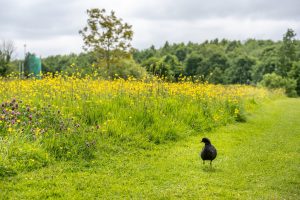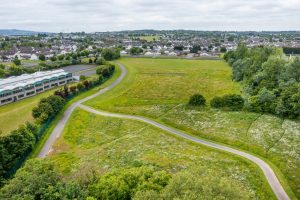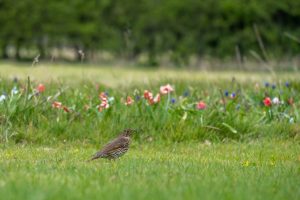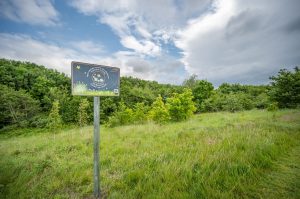Brendan Redmond, Executive Parks Superintendent at South Dublin County Council, tells us about the work the council is doing for pollinators and biodiversity.

2022 has been a very successful year to date. Work that has been carried out on our meadows in previous years has really started to pay dividends with spectacular displays of wildflowers across the county throughout the summer period. These results are very encouraging, and we expect that the meadows will continue to improve as the management practices continue year on year.
This short video gives an update on some of the species that have appeared this year:
We are getting an overwhelmingly positive response from the elected members and the general public, and we are leading the way in the local authority sector in terms of implementing the All-Ireland Pollinator Plan. Recently the All-Ireland Pollinator Plan (AIPP) has tweeted congratulating South Dublin County Council on the way the Council is managing the landscape with over 160ha of long flowering meadows now managed for pollinators.
Long Flowering Meadows
South Dublin County Council currently manages over 160ha of long flowering meadows with over 100ha of long flowering meadows are being cut and collected by a contractor working on behalf of the Council in in Aug/Sept 22 (the remaining 60 ha was cut in spring). The meadow mowing generates over 3,700 tonnes of grass cuttings which is re-used as fodder.
Meadow management is an essential part of the Councils actions to improve habitats for pollinators. Some of the meadows are cut at the end of the flowering season while others are left to overwinter and are cut later in the Spring to provide winter hibernation places for insects and their larvae.
Cutting meadows at any time of the year (spring or autumn) frequently generates complaints from members of the public. Some complaints are concerned with the immediate impact of removing the wildflowers while others mistakenly believe that meadows are purely natural ecosystems that require no intervention.
This, however, is not the case. If the council did not properly manage the meadows, most would return to rank grassland and lose their benefits to pollinators. To increase awareness regarding required meadow management we have released a wildflower meadow life-cycle video to help explain this process: (https://youtu.be/MiUAwnfNIcs)
The meadow management techniques used by SDCC are aligned with best practice and are supported by the All-Ireland Pollinator Plan and requires the meadows be cut once per year, either in autumn or spring, with grass cuttings removed. This depletes the soil of nitrogen, allowing natural wildflowers to grow and establish. The areas that SDCC manage for pollinators has grown from 90ha in 2019 to over 160ha in 2022, and this figure is growing year on year.
Visit this link to view South Dublin County Council’s long-flowering meadow map.

Short Flowing Meadows
South Dublin County Council are also currently conducting a County wide trial on short-flowering meadows. This involves areas which were previously cut every couple of weeks adopting a reduced mowing regime where we will cut and collect the grass 5 times per year. Short-flowering meadows are designed for public open space and residential areas where long-flowering meadows aren’t suitable, but where we want to allow more biodiversity value in these grassed areas. The trial locations are spread throughout South Dublin County and comprise 10 hectares in total. In the summer of 2022, South Dublin County Council released an educational video on short flowering meadows:
The short-flowering meadows initiative has the potential to be an environmentally beneficial way of managing public open space and is an objective within the All-Ireland Pollinator Plan. The cutting and collecting programme will allow short flowering species to flower and set seed and will reduce the overall competition from grass species as the ground is depleted of nitrogen. This initiative has the potential to vastly expand the areas we manage for pollinators.
If the trial is successful, residents’ associations will be able to request areas within their estates to be left as short meadows to promote pollinator food sources and habitats. This type of management is perfect for allowing plants such as dandelions to flower, but where long-flowering meadows would not be suitable. The selection criteria are very stringent to ensure this initiative doesn’t hinder future or existing use of public open space. The trial has been very successful to date and South Dublin County Council plan continue this successful management approach.
You can view the South Dublin County Council short-flowering meadow map here.
Urban Planting & Bulb Schemes
In addition to our meadows, the South Dublin County Counil Public Realm Improvement Works include seven urban pollinator friendly perennial schemes which have been completed in 2022. These schemes are located at Sean Walsh & Tymon Park entrances, Belgard Square North/East junction, Stocking Wood, Rathfarnham Village, Tallaght Village and Whitestown Way.
Pollinator friendly perennial plants are excellent sources of pollen and nectar. The planting scheme is densely planted to provide an array of visual colour as well as being more attractive to our pollinators. The planting scheme has been designed to provide a food source from spring through to autumn as well as providing habitats and nesting materials/value for birds and insects.
In Autumn and Winter, South Dublin County Council plan on planting over 2.5 million pollinator friendly bulbs in various locations across the county. These bulbs will provide additional soft ecological corridors as well as vital resources for hungry pollinators.

Raising Awareness and Social-Media
South Dublin County Council has continued a social media campaign to promote pollinators and the actions set out in the AIPP/SDCC Pollinator Action Plan. For instance, over the past 3 months we have produced 3 pollinator videos to raise awareness on South Dublin County Council actions.
On the ground we have installed over 80 new South Dublin County Council-specific ‘Managed for Wildlife’ & ‘Lets Create a Buzz’ signs to assist with education on the councils’ actions and the results have been positive to date. If people want more information on pollinators, they can scan the QR code located on the signs this directs people back to the council’s web page where they can view our local pollinator action plan & videos.
In addition, South Dublin County Council are developing training videos for groups interested in improving their local area for pollinators. The council’s Biodiversity Plan is in place supporting the above work, and the Green Infrastructure Strategy for the county has been finalised and is part of the County Development Plan. The Sustainable Urban Drainage Guidelines for SDCC was developed, the implementation of nature-based drainage solutions will support pollinators habitats and provide food opportunities for pollinators.

The Future
South Dublin County Council have been considering use of the grass as an energy source through an anaerobic digestion system. The long-term consideration, if the feasibility stage was successful, is that we could begin to contribute to the energy costs of a works depot (buildings and machines) using the energy that the grass provides through the digestion systems. The council are currently exploring this and doing some market research prior to publishing a tender for an anaerobic digestion feasibility survey.
Find out more:
South Dublin County Council’s long-flowering meadow map
South Dublin County Council’s short-flowering meadow map
